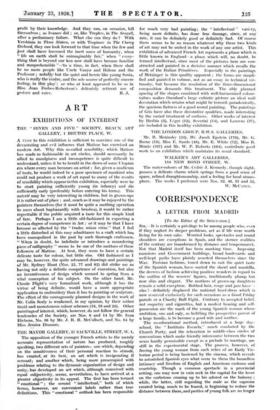ART
EXHIBITIONS OF INTEREST
THE "SEVEN AND FIVE " SOCIETY, BEAUX ART GALLERY, 1 BRUTON PLACE, W.
A visrr to this exhibition is sufficient to convince one of the devastating and evil influence that Matisse has exercised on modern Art. Why this so-called sensibility, which Matisse has made so fashionable in art circles, should necessarily be allied to smudginess and incompetence is quite difficult to understand, unless it be to herald in the dawn of some Utopian era where every man becomes an artist ; for, given a modicum of taste, he would indeed be a poor specimen of mankind who could not produce a work of art equal to many of the results of sensibility which appear in this exhibition, especially were he to start painting sufficiently young (in infancy) and die sufficiently early (preferably before entering his teens). This naivete may be very interesting in children, but in grown-ups it is rather out of place ; and, much as it may be enjoyed by the painters themselves (for it must be quite a soothing operation to mess about haphazardly with brushes), it would be rather regrettable if the public acquired a taste for this simple kind of fare. Perhaps I am a little old-fashioned in expecting a certain ctegree of competence in Art ; or it may be that I have become so affected by the " trades union virus " that I feel a little disturbed at this easy admittance to a craft which has been monopolized in the past by such thorough craftsmen. " When in doubt, be indefinite or introduce a meandering piece of calligraphy " seems to be one of the mottoes of these followers of Matisse. At best, they seem to have a certain delicate taste for colour, but little else. Old fashioned as I may be, however, the quite advanced drawings and paintings of Mr. Sydney Hunt (Nos. 25, 77 and 82) did strike me as having not only a definite competence of execution, but also an inventiveness of design which seemed to spring from a vital conception of his subject. On the other hand, Mr. Claude Flight's very formalized work, although it has the virtue of being definite, would have a more appropriate application to embroidery than it has to painting or sculpture. The effect of the courageously planned designs in the work of Mr. Colin Sealy is weakened, in my opinion, by their rather timid and monotonous colour schemes (18, 19 and 23). Other paintings of interest, which, however, do not follow the general tendencies of the Society, are Nos. 6 and 14 by Mr. Ivon Hichens, No. 36 by Mr. J. R. R. McCulloch, and No. 64 by Miss Jessica Dismorr.
THE. MAYOR GALLERY, 37 SACKVILLE, STREET, W. 1.
The opposition of the younger French artists to the merely accurate representation of nature has produced, roughly speaking, two different sets of painters; one which, depending on the sensitiveness of their personal reaction to stimuli, has created,- at its best, an art which is invigorating if sensual; and another which, being more preoccupied with problems relating to the dynamic organization of design and unity, has developed- an art which, although conceived with equal subjectivity, seems, nevertheless, to have arrived at a greater objectivity in its appeal. The first has been termed " emotional " ; the second " intellectual," both of which terms, however, are convenient labels rather than true definitions. This " emotional " outlook has been responsible
for much very bad painting ; the " intellectual " variety, being more definite, has done less damage, since, at any rate, it can be definitely good or definitely bad. Of course there seems to be no reason whatever why these two kinds of art may not be united in the work of any one artist. This exhibition of advanced French Art represents a phase which is little known in England—a phase which will, no doubt, be termed intellectual, since most of the pictures here are con- structed and painted in a decisive manner which recalls the work of the Italian Primitives. Especially in the paintings of Metzinger is this quality apparent ; the forms are simpli- fied and painted in volume, not as an essay in technical vir- tuosity, but because the resolution of the three-dimensional composition demands this treatment. The ably planned spacing of the shapes combined with well-harmonized colour- values makes Ozenfant's large cubistic picture an ideal wall decoration which retains what might be termed, paradoxically, the spacious flatness of a good mural painting. The paintings of Gris have also these decorative qualities, made interesting by the varied treatment of surfaces. Other works of interest by Herbin (3), Leger (12), Severini (14), and Laurens (37), are included in this healthy exhibition.
THE LONDON GROUP, R.W.S. GALLERIES.
Mr. B. Meninsky (34), Mr. Jacob Epstein (170), Mr. G. Barne (78), Miss E. Sands (48), Mr. E. White (72), Miss B. Muntz (167) and Mr. W. P. Roberts (164), contribute good work to an exhibition which maintains its usual standard.
WALKER'S ART GALLERIES, 118 NEW BOND STREET, W.
The water-colours of Mr. Cedric J. Kennedy, though slight, possess a delicate charm which springs from a good sense of space, refined draughtsmanship, and a feeling for local atmos- phere. The works I preferred were Nos. 32, 46, 51 and 52.
W. McCAsrcE.










































 Previous page
Previous page